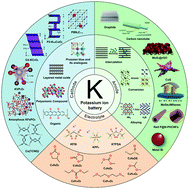Potassium-ion batteries: outlook on present and future technologies
Abstract
The limited resources and uneven distribution of lithium stimulate strong motivation to develop new rechargeable batteries that use alternative charge carriers. Potassium-ion batteries (PIBs) are at the top of the list of alternatives because of the abundant raw materials and relatively high energy density, fast ion transport kinetics in the electrolyte, and low cost. However, several challenges still hinder the development of PIBs, such as low reversible capacity, poor rate performance, and inferior cycling stability. Research on the cathode is currently focused on developing materials with high energy density and cycling stability, mainly including layered transition metal oxides, polyanion compounds, organic compounds, etc. Anodes based on intercalation reactions, conversion reactions, and alloying with potassium are currently under development, and promising results have been published. This review comprehensively summarizes the research effort to date on the electrode material optimization (e.g., crystals, morphology, reaction mechanisms, and interface control), the synthesis methods, and the full cell fabrication for PIBs to enhance the electrochemical potassium storage and provide a platform for further development in this battery system.

- This article is part of the themed collection: Battery science and technology – powered by chemistry


 Please wait while we load your content...
Please wait while we load your content...